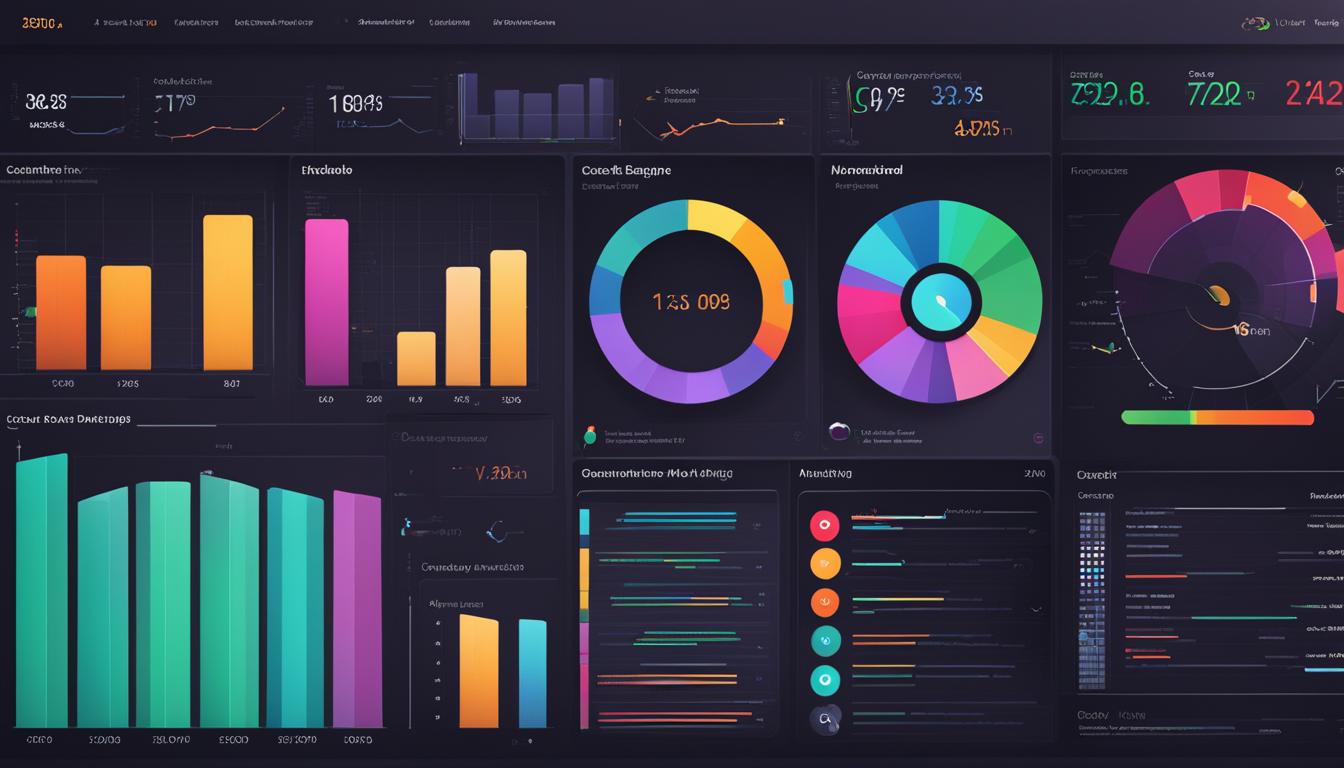When it comes to optimizing your website for search engines, having access to SEO data is essential. However, simply collecting data is not enough. To truly harness the power of SEO analytics, you need to interpret the data and take action based on your insights.
SEO data interpretation involves analyzing various metrics and indicators to understand your website’s performance in search engine rankings. By diving deep into SEO performance analysis, you can identify strengths and weaknesses, uncover opportunities for improvement, and make data-driven decisions to drive your SEO strategies forward.
Optimizing your website based on SEO insights can lead to improved visibility, increased organic traffic, and higher conversion rates. By understanding SEO measurement metrics and using them to guide your SEO optimization efforts, you can stay ahead of the competition and achieve long-term success in the ever-evolving digital landscape.
Key Takeaways:
- Interpreting SEO data is crucial for optimizing your website’s performance.
- Analysis of SEO metrics helps you make data-driven decisions to improve rankings.
- Take action based on SEO insights to increase visibility and drive organic traffic.
- Understanding SEO measurement metrics guides your SEO optimization strategies.
- By acting on SEO data, you can achieve long-term success in organic search.
Understanding Bounce Rate and Clicks
In the realm of SEO analytics, bounce rate and clickthrough rate are two crucial metrics that provide valuable insights into user engagement and website performance. Let’s dive deeper into what these metrics entail and how they impact your website’s success.
The Importance of Bounce Rate
Bounce rate refers to the percentage of single-page sessions on your website. It measures the number of visitors who leave your site without exploring further beyond the landing page. A high bounce rate suggests that visitors are not engaging with your content, which can negatively impact your SEO efforts.
Optimizing bounce rate is essential to increase user engagement and drive conversions. By analyzing this metric, you can identify areas for improvement in your website’s layout, content, and user experience.
The Significance of Clickthrough Rate
Clickthrough rate (CTR) represents the number of times users click on a website link from the search results page. It measures the effectiveness of your meta descriptions, headlines, and overall search engine visibility. A high CTR indicates that your website is attracting the attention of search engine users.
Analyzing clickthrough rate can provide insights into the success of your SEO strategies and the relevance of your website content. By optimizing your meta descriptions and headlines, you can entice users to click on your website link, driving more organic traffic.
Enhancing User Engagement and Driving Conversions
Improving bounce rate and increasing clickthrough rate are key to boosting user engagement and driving conversions. By offering valuable and relevant content, optimizing your website’s layout, and captivating users with compelling meta descriptions and headlines, you can create a positive user experience, ultimately leading to higher conversion rates.
Remember, a low bounce rate indicates that users are actively engaging with your website and exploring multiple pages, which increases the likelihood of conversions. Similarly, a high clickthrough rate suggests that users find your website appealing and are more likely to convert.
| Metric | Definition |
|---|---|
| Bounce Rate | The percentage of single-page sessions, indicating the rate at which users leave your website after viewing only one page. |
| Clickthrough Rate (CTR) | The number of times users click on a website link from the search results page, indicating the effectiveness of meta descriptions and headlines. |
| User Engagement | The level of user interaction and involvement with your website, measured by factors such as session duration, page views, and event tracking. |
| Session Duration | The length of time users spend on your website during a single session, indicating their overall engagement and interest. |
| Conversion Rate | The percentage of website visitors who complete a desired action, such as making a purchase or filling out a form. |
| Exit Page | The last page users visit before leaving your website, highlighting areas that may require improvement or further optimization. |
Analyzing Entrances, Events, and Exit Pages

When it comes to optimizing website performance and enhancing user experience, analyzing entrances, events, and exit pages plays a crucial role. These metrics provide valuable insights into user behavior, help identify areas of weakness, and optimize the conversion funnel. By understanding how users enter and exit a website, as well as the actions they take in between, we can make informed decisions to drive better results.
Entrances: The first step in analyzing user behavior is to examine entrances, which refer to the different pages on a website where users enter. This metric provides insights into which landing pages are driving the most traffic and attracting users. By identifying the high-performing entrance pages, we can optimize them further to enhance user engagement and increase conversions.
Events: Tracking user actions and events that occur on a website is crucial for measuring user engagement. Events can range from clicks on specific elements, form submissions, downloads, or any other interaction that adds value to the user experience. By tracking events, we can gain insights into the actions users are taking and measure the effectiveness of our website’s features and functionalities.
Exit Pages and Exit Rate: Exit pages indicate the pages where users leave a website. Analyzing exit pages helps us identify potential weaknesses or areas for improvement. By understanding why users are leaving at specific pages, we can optimize those pages to retain users and reduce the exit rate. Monitoring the exit rate allows us to track the percentage of users leaving our website after viewing a specific page, providing further insights into user behavior and potential improvements.
To illustrate the importance of analyzing entrances, events, and exit pages, let’s take a look at the following table:
| Page | Entrances | Events | Exit Pages |
|---|---|---|---|
| Homepage | 500 | 350 | 250 |
| Product A | 400 | 250 | 150 |
| Product B | 300 | 200 | 100 |
| Blog | 200 | 150 | 50 |
Looking at the table, we can see that the homepage has the highest number of entrances, indicating that it is successful in attracting visitors. However, there is a significant number of exits, which suggests that there might be issues with the overall user experience on the homepage. By analyzing the events on each page, we can further understand user behavior and identify patterns that may contribute to the exit rate. This analysis can help us make informed decisions to optimize the user journey, improve the conversion funnel, and enhance the overall website performance.
By focusing on analyzing entrances, events, and exit pages, we can gain valuable insights into user behavior, optimize the user journey, and improve conversions. It is essential to continually monitor these metrics and make data-driven decisions to enhance website performance and deliver a seamless user experience.
Understanding Hits, Impressions, and Page Views

When it comes to analyzing website performance and evaluating SEO strategies, hits, impressions, and page views are critical metrics to consider. Let’s take a closer look at what these metrics entail and how they contribute to SEO performance.
Hits
Hits refer to the number of requests made to a web server for specific files like web pages or images. Each time a visitor accesses a file on your website, it counts as a hit. While hits are an important measure of overall server activity, they alone do not provide a comprehensive understanding of user behavior or engagement.
Impressions
Impressions track the number of times a website link appears in search results. This metric indicates the exposure and visibility of your website to potential visitors. The higher the number of impressions, the greater the potential for clicks and organic traffic. Understanding impressions can help you assess the impact of your SEO efforts on search engine result pages (SERPs).
Page Views
Page views measure the number of times a visitor lands on any page of your website. It quantifies the overall traffic your website receives. When a user navigates between multiple pages during a single session, each new page view is counted. Unique page views, on the other hand, account for repeated views of the same page by the same person within a single session.
Analyzing hits, impressions, and page views can provide valuable insights into your website’s SEO performance. By monitoring and interpreting these metrics, you can assess the effectiveness of your optimization efforts, calculate important metrics like clickthrough rate (CTR), and understand how users navigate through your website.
“Hits, impressions, and page views are like windows into your website’s SEO performance. By understanding these metrics, you can uncover valuable insights to drive further optimization and increase organic traffic.”
– SEO Insights Expert
Analyzing Sessions and Time on Page

Sessions and time on page are crucial metrics for assessing user interaction and website engagement. By understanding these metrics, we can optimize website content and enhance user experience, ultimately driving higher rankings and conversions.
Sessions: Time Spent on Your Website
Sessions represent the amount of time visitors spend on your website, and each action they take is recorded as a hit. A session begins when a user enters your site and ends after a period of inactivity or when they leave the site. By analyzing sessions, we can gain insights into how users interact with our website.
Different websites may have varying session durations depending on their content and purpose. For example, an e-commerce website may aim for longer sessions as it indicates user engagement and a higher likelihood of making a purchase. On the other hand, a blog or news website may focus on delivering valuable content within shorter sessions.
“Sessions allow us to understand how engaged users are with our website. By analyzing session duration, we can identify opportunities to improve user interaction and overall website engagement.”
Time on Page: Engaging Content and User Interest
Time on page measures the average amount of time visitors spend on a specific page of your website. It provides insights into the level of engagement and interest users have in your content. By analyzing time on page, we can determine whether our website is effectively capturing and retaining user attention.
Understanding time on page is particularly important for pages with high exit rates. If users are leaving a page quickly, it may indicate that the content is not engaging or relevant enough. By optimizing content and layout based on time on page data, we can improve user experience and encourage users to stay on our website longer.
To increase time on page, consider incorporating engaging elements such as videos, interactive features, or related content recommendations. This can capture user interest and encourage exploration of your website, ultimately driving higher levels of engagement.
| Key Metric | Definition |
|---|---|
| Sessions | The amount of time visitors spend on a website, recorded as hits. |
| Average Session Duration | The average length of a session, indicating user interaction. |
| Time on Page | The average amount of time visitors spend on a specific page, reflecting user engagement and interest. |
| User Interaction | The actions users take on a website, such as clicks, scrolling, and form submissions. |
| Website Engagement | The level of user involvement and interaction with a website. |
Analyzing Keyword Distribution and Branded vs. Unbranded Keywords

Understanding keyword distribution and the differentiation between branded and unbranded keywords is vital for effective SEO strategies. By examining the types of keywords that drive traffic to a website, SEO professionals can optimize their keyword targeting and improve search engine rankings.
One way to analyze keyword distribution is by categorizing them into head terms, middle terms, tail terms, and long-tail keywords. Head terms typically have high search volumes and are broad, while middle and tail terms are more specific. Long-tail keywords are even more specific and often longer phrases that target niche search queries.
Examining the distribution of keywords across these categories provides insights into the effectiveness of SEO efforts. For example, if a website receives the majority of its traffic from long-tail keywords, it suggests that the content is addressing specific user queries and attracting a highly targeted audience. Conversely, if a significant portion of the traffic comes from head terms, it may indicate a need to refine the SEO strategy to attract more relevant traffic.
In addition to keyword distribution, analyzing branded and unbranded keywords can offer valuable insights into SEO performance. Branded keywords include specific brand names or variations, while unbranded keywords do not contain any specific branding. By monitoring the performance of branded and unbranded keywords, SEO professionals can gauge the impact of their branding efforts and capture potential customers at different stages of the buyer’s journey.
For instance, if a website receives a significant amount of traffic from branded keywords, it suggests that the brand is already well-known and recognized. On the other hand, if there is a notable volume of traffic from unbranded keywords, it indicates that the brand is effectively attracting users who are in the discovery phase and may convert into customers.
In conclusion, analyzing keyword distribution and distinguishing between branded and unbranded keywords are crucial for optimizing SEO strategies. By understanding which types of keywords are driving traffic and how branding impacts search visibility, SEO professionals can make informed decisions to improve rankings, attract relevant audiences, and maximize website visibility.
Conclusion
In conclusion, SEO data analysis is an indispensable tool for optimizing website performance and driving organic traffic. By carefully examining key metrics such as bounce rate, clickthrough rate, entrances, events, exit pages, hits, impressions, page views, sessions, and time on page, I can gain valuable insights into user behavior and website engagement. Armed with this knowledge, I can make data-driven decisions and implement effective SEO optimization strategies that will improve search rankings, increase user engagement, and ultimately drive conversions.
The power of SEO data analysis lies in its ability to uncover hidden patterns, identify areas for improvement, and guide strategic decision-making. By interpreting and acting on these insights, I can boost website visibility and establish long-term success in organic search. Whether it’s refining landing pages, optimizing content, or targeting specific keywords, the data-driven approach ensures that my actions are rooted in evidence and have the highest probability of success.
Driving organic traffic and increasing website visibility is a top priority for any business, and SEO data analysis provides the roadmap to achieve these goals. By continuously monitoring and analyzing performance metrics, I can fine-tune my SEO optimization strategies and stay ahead of the competition. In today’s digital landscape, success is driven by data, and by harnessing the power of SEO data analysis, I can unlock the full potential of my website and drive its growth like never before.









